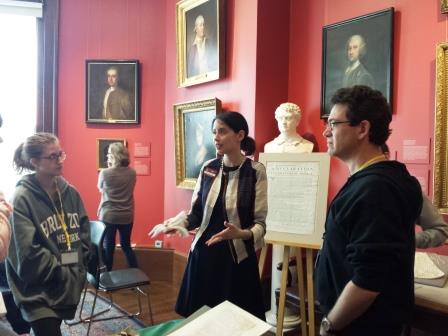By Kathleen Barker, Center for the Teaching of History
What is evidence? What can historians do with the evidence they collect and interpret? On May 13, 2017, a dedicated group of middle-school students tackled these very questions as they immersed themselves in the lives of men, women, and children whose papers reside in MHS collections. The Society’s Center for the Teaching of History collaborated with the Johns Hopkins Center for Talented Youth to host 25 students, parents, and grandparents from across the Northeast for a day of family inquiry. In just a few hours, families experienced the thrill of collecting sources, the challenges of interpreting their findings, and the rewards of sharing their discoveries with classmates.

Adams Papers Editor Sara Georgini and participants discuss the evidence.
The morning began with an exploration of the kinds of sources historians use to tell stories about the past. Families toured our new exhibition “The Irish Atlantic,” analyzing everything from portraits and poems to statistics and a ship’s wheel. While they were asked to look for answers in specific objects, students were also encouraged to ask questions about what they were finding—and not finding—in their sources. This process of questioning sources continued in our next sessions, which focused more specifically on documents and artifacts from the American Revolution and the Civil War. Sara Georgini, Series Editor of the Papers of John Adams, used five items from each period to demonstrate how historians connect diverse types of evidence, created at multiple times by many different makers, to tell a more complex story about a particular event. Librarian Peter Drummey then modeled a different kind of storytelling, using artifacts, photographs, and documents related to John Brown to help students imagine the life of the infamous abolitionist.
By the end of the day participants were ready to use their accumulated discoveries to draft their own piece of historical fiction. CTH director Kathleen Barker led families in a step-by-step writing exercise that led to the creation of several imaginative and evocative stories starring MHS “characters” and collection items. Students shared stories of Massachusetts soldiers caught in slaughter of Antietam and nurses attempting to care for wounded men during the chaos of battle. Other families reimagined the American Revolution from the perspectives of Abigail Adams, John Hancock, and even Paul Revere’s horse! We look forward to adding more of these inter-generation events to the Center’s expanding calendar of events. Do you have suggestions for family activities? Share them with us at education@masshist.org.

